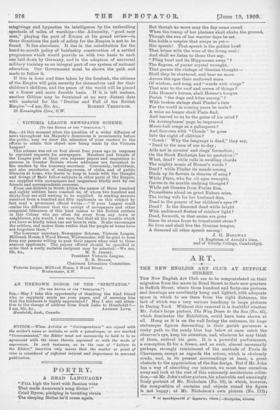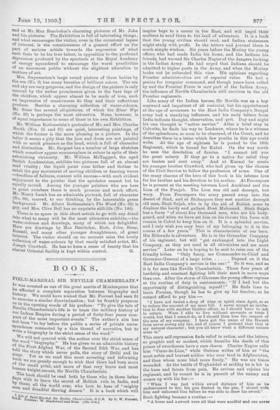ART.
THE NEW ENGLISH ART CLUB AT SUFFOLK STREET.
THE New English Art Club are to be congratulated on their migration from the mews in Bond Street to their new quarters in Suffolk Street, where three hundred and forty-one pictures and drawings are excellently hung and lighted, with adequate space in which to see them from the right distances, the lack of which was a very serious handicap to large pictures in Dering Yard. .Without this removal it is doubtful whether Mr. John's large picture, The Way Down to the Sea (No. 41), which dominates the Exhibition, could have been shown at all. Hung as it is on the wall facing the entrance, its huge statuesque figures descending in their garish garments a rocky path to the sandy blue bay below at once catch the observer's eye, keep his attention, and, whatever he may think of them, enthral his gaze. It is a powerful performance, a conception fit for a fresco, and as such, almost necessarily perhaps, strongly reminiscent of the methods of Puvis de Chavannes, except as regards the colour, which is obviously crude, and, in its present surroundings at least, a great obstacle to the appreciation of the fine design. But if Mr. John has a way of absorbing our interest, we must tear ourselves away and look at the rest of this extremely meritorious collec- tion,—at Mr. John's other picture, his admirable and amazingly lively portrait of Mr. Nicholson (No. 58), in which, however, the composition of curtains and objects round the figure is not happy ; at Mr. Nicholson's own picture (No. 112); I Ti irpoo•E‘pcecrOi .14osticriv, Tim% ;.—Euripides; Akiesui,
and at Mr. Max Beerbohm's charming pictures of Mr. John and his pictures. The Exhibition is full of interesting things; and what encourages the visitor, even in the occasional lapses of interest, is the consciousness of a general effort on the Part of serious artists towards the expression of what each feels to be his true talent, in opposition to the profound depression produced by the spectacle at the Royal Academy of energy squandered to encourage the worst proclivities of an enormous public without the slightest education in matters of art. •
Mrs. Swynnerton's large round picture of three babies by the sea (No. 3) has many beauties of brilliant colour. The sea and sky are very gorgeous, and the design of the picture is only marred by the undue prominence given to the bare legs of the children, which appear almost to be made of iron, such an impression of massiveness do they and their reflections Produce. Besides a charming collection of water-colours, Mr. Steer has several oil-pictures, of which the River Wye (No. 29) is perhaps the most attractive. None, however, is of equal importance to some of those in his own Exhibition.
Mr. William Rothenstein's portraits of Mr. and Mrs. Charles Booth (Nos. 55 and 61) are quiet, interesting paintings, of which the former is the more pleasing as a picture. In the latter it seems a pity that the lace and dress are not painted with so much pleasure as the head, which is full of character and distinction. Mr. Sargent has a number of large sketches which somehow appear commonplace in colour in spite of their astonishing virtuosity. Mr. William McTaggart, the aged Scotch Academician, exhibits two pictures full of an almost mad vitality; the liquid paint runs hither and thither to catch the gay movement of moving children or dancing waves --heedless of failures, content with success—with such evident enjoyment to the painter that the spectator cannot but be equally moved. Among the younger painters who are here in great numbers there is much promise and much effort. Mr. Henry Lamb has an admirable portrait, full of character (No. 86), marred, to our thinking, by the lamentable green background. Mr. Albert Rothenstein's The Wood (No. 82) is say, and Mrs. Clive Bell has an exquisite still-life (No. 146).
There is no space in this short article to go with any detail into what to many will be the most attractive exhibits,—the water-colours and drawings, many of which are delightful. Here are drawings by Max Beerbohm, Rich, John, Steer, Russell, and many other younger draughtsmen, of great interest. The visitor should on no account miss the lovely collection of water-colours by that rarely satisfied artist, Mr. Joseph Crawhall. He has so keen a sense of beauty that his almost Oriental facility is kept within control. G.











































 Previous page
Previous page